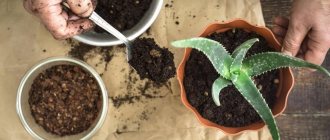Citrus plants, even when grown indoors, are large plants (with the exception of dwarf varieties). Consequently, they require large pots (which typically have to be placed on the floor). Exposed soil in a large pot doesn't look very attractive. But there is a good solution: add other plants to citrus plants (lemons, tangerines, oranges, pomelo, limes...) as companions that will act as ground cover. This way you will save space, and pots of citrus fruits will look more interesting.
If possible, it is advisable to take pots of citrus fruits out into the yard during the warm season. In this case, companions can be annuals, they can help your potted tree by saving it from insect pests and protecting the soil from drying out. In this case, there are even more variations in what can be added to citrus than when keeping the plant strictly indoors.
Terracotta Pots with Citrus PlantsLarge terracotta pots fit perfectly into the style and architecture of any home. Placing it in a pot provides ample space for fruit trees. They can be brought into the greenhouse for the winter, and outside in the garden in the summer. However, they can completely dominate a space. In this case, low growing plants planted around them is a simple solution, creating the effect that the pots form one large garden.
. This softens the transition between paving stones and flowerpots, effectively “grounding” them in space. Select a type of container that matches the architecture of your home and plant ground cover plants or herbs in the containers.
Although citrus fruits are a subtropical genus
, northern gardeners can grow lemons, oranges and other citrus trees in containers to enjoy fresh fruit from their tree without leaving home. Orange and grapefruit trees can grow 6-8 meters in height, while dwarf varieties grow up to 1.5-2 meters. Most citrus fruits are self-fertile, so cross-pollination is not necessary for fruiting; one tree is enough. On average, citrus fruiting in open ground begins at the age of 3 to 6 years (in the room you will have to wait 10-15 years, but when you buy grafted plants, this period is reduced, they can bear fruit almost immediately), however, the exact timing will depend on the type of citrus fruit (lemons, oranges, grapefruits, etc.), variety, climate, plant health and care, as well as other factors. Citrus flowering is not seasonal, occurring in warm weather all year round. Flowers and fruits can be on the tree at the same time.
Citrus has a shallow root system
, so he does not like competition from vigorous plants that have a deep root system (such as tansy).
But here you need to look at the age and size of the plant.
The reason why you shouldn't plant anything directly under a citrus tree (close to the trunk) is foot rot, which citrus trees are susceptible to. However, at some distance from the trunk, closer to the edge of the pot, companions are very useful for citrus fruits
. Wildflowers and herbs, especially milkweed (it prefers semi-shaded habitats and light, humus-fertilized soils), will attract beneficial insects (if placed in the garden in summer) and help citrus fruits grow (in any case, even indoors). Mulch (usually bark, but you can also use pebbles) is ideal for citrus fruits. If you want to plant flowers and herbs, keep them around the perimeter.
Mulch in open ground
not recommended for citrus trees, but if mulch is used, leave some bare soil between the tree trunk and the mulch (weed killer herbicides can be used in this space).
Companions for large citrus fruits
Ginger in a pot with citrus fruits
If you are looking for a companion plant for your mature lemon, orange, or grapefruit that is easy to care for, consider ginger (you can buy the root at any grocery store), it likes to grow in the shade. Ginger has shallow roots, the height of the leaves reaches 50 cm, and resembles a small bamboo.
Garlic, clover, fern in a pot with citrus fruits
Garlic and clover are also suitable for planting with citrus fruits.
If you have a large and mature citrus, fern and clivia (on the shady side) can grow with it. In the sun, citrus and garlic are perfect. But there is no need to plant companions close to the trunk. It is better to leave free space right under the tree and mulch the soil around the trunk with crushed bark.
Planting with companions eliminates many problems: no fertilizers, while the tree produces a bountiful harvest of excellent lemons and oranges. Citrus trees require some dry soil and very little fertilizer
. Over-fertilizing your citrus will limit your yield.
In greenhouses and open ground, lemons are sown around with clover
for nitrogen, clover can also be planted in a large container with citrus (again, not close to the trunk, but at some distance).
Clover is often used as a ground cover crop. Since it is a member of the legume family, it is a nitrogen fixer and a good companion for citrus fruits and any other plants. It is widely used in organic gardening. It also usually requires less water than grass because its root system is much deeper, naturally aerating the soil. Just try to keep the trunk away from vegetation.
Citrus leaves turn pale due to lack of nitrogen, and planting legumes (clover, fire beans, and other plants) helps lemons with nitrogen, and garlic cloves will help repel insects, while at the same time flowers and herbs can attract bees for pollination. .
Violets in one pot with lemons and other citrus fruits
Violets under a lemon tree (and any other citrus tree) grow and flourish almost without your help. Citrus tree and violets are good company.
From personal experience:
Young violets planted in pots with citrus trees practically stopped growing; in the summer they sat there for a couple of months and did not grow. As a result, they were planted in small pots, and pelargoniums were added to the citrus trees.
Based on the experience of the first season, it turned out to be a wonderful neighborhood.
Pelargoniums in one pot with citrus fruits
As an experiment, we planted zonal pelargoniums grown from seeds in large pots with citrus fruits. Let's look at two pelargoniums and calamondin:
Spring: calamondin and two young zonal pelargoniums grown from seeds.
Summer, some time after planting together: everyone is growing and doing well.
Autumn (September): one of the pelargoniums has grown large and bloomed, the second has not yet. Calamondin feels good, blooms, and has small fruits.
Young fruits of calamondin growing together with pelargoniums.
Two calamondins for comparison. Bought from the same nursery at the same time, they were practically twins and were the same size. Soil, watering, fertilizing are the same. The one with pelargonium looks a little better: its leaves do not turn yellow and it is now a little taller in size.
It remains to be seen what will happen a year or two after such a neighborhood. We will add information next year, 2018.
Compatible Color Combinations
Not only novice amateur gardeners can face the problem of incompatibility of indoor plants. Experienced plant growers are also not always able to properly organize the neighborhood. This is due to the fact that exotic flowers are increasingly appearing in people’s homes, which previously could not be seen in local flower shops. Therefore, to understand how friendly a particular plant is, observation and personal experience are necessary.
You can achieve harmony in your home garden if you adhere to the indicated scheme. It shows combinations of indoor flowers that are most often found in home flower beds.
| Types of compatible plants | Characteristic |
| Cactus, begonia, chlorophytum, spathiphyllum, monstera, alocasia, kala, calla, aspidistra, eucharis | Deciduous and flowering plants. They are classified as slow growing. |
| Orchid, Decembrist, schisanthus, vanda, aloe, cactus, palm, violet | Plants that need a lot of light. They feel best on the windowsill in the living room. |
| Tradescantia, pilea, bamboo, dracaena, cordyline | Flowers love diffused light. They need regular moistening and spraying. |
| Home rose, eustoma, hibiscus, indoor jasmine | Needs additional lighting. Abundant watering is required. In winter, fertilizing and artificial light should be provided. |
| Stromantha, money tree, peperomia | Unpretentious plants that tolerate dry air well and love abundant watering. You need to carefully monitor the root system, as it is susceptible to rot. |
Subtleties of caring for citrus fruits at home
In the first year after planting citrus fruits, remove all ovaries. This will allow the tree to get stronger and will contribute to better fruiting next season.
As the young plant grows, you need to replenish the nutrients used by your citrus. This ensures that the plant grows to its full potential. Feed citrus trees in the spring and summer for maximum fruiting and flowering.
Epsom salt has different names: bitter salt, Epsom salt, bitter earth, magnesia. Known medically as magnesium sulfate heptahydrate (MgSO4), or simply magnesium sulfate (can be purchased at the pharmacy)
. The mineral contains magnesium and sulfur. This salt has a bitter taste (can be consumed internally).
Citrus fruits require higher levels of potassium and magnesium
than other plants.
Magnesium deficiency is a common problem in citrus fruits and is indicated by yellowing leaves. Using Epsom salts
(sprinkle a little on the ground).
Citrus trees require more watering during the summer months. Well-watered citrus will have a better chance of being able to withstand pests and diseases without any protective equipment.
Protect your plants with several layers of mulch to help keep the roots moist. And keep the area around citrus fruits free of weeds.
Whiteflies and aphids can attack your citrus fruits. Inspect plants for insect attacks.
Remove any diseased stems to improve air circulation. But remember that leaves are the life of the tree, so don't cut unnecessarily, especially before the tree is about to bear fruit.
Planting lemons and other citrus fruits from seeds
Lemon seedlings. Citrus trees require placement on a sunny side protected from wind/draft.
Trees can be planted at any time, however, spring is the best time for plants in containers. Young plants from lemon seeds.
Planting citrus fruits is easy:
We take seeds from the desired fruit (lemon, tangerine, orange, pomelo, and others), soak the seeds overnight in water and plant them to a depth of about 1 cm in well-moistened soil. Cover the pot with a plastic bag or film and place it in a warm and sunny place. You may have to wait for germination for several weeks; ventilate the greenhouse periodically. Then, after germination, remove the plastic, but continue to keep the pot in a warm and sunny place.
During the first few years (until fertile age), you need to feed the tree with balanced fertilizers. Nutrients ensure good leaf growth.
Orchid root system - structural features
The orchid root system consists of main and adventitious (aerial) roots.
In monopodial varieties, adventitious roots grow on the stem, and in sympodial varieties, on the rhizomatous portion of the shoot. The orchid requires a lot of nutrition, so the roots grow greatly. Information! A large number of adventitious roots is evidence that the orchid is comfortable in the created conditions.
All roots are covered with a coating (velmen) of dead cells filled with air. Velmen stores moisture and is necessary for protection from damage.
Functions of roots:
- fixation in the substrate, maintaining a vertical position;
- in them, as in leaves, the process of photosynthesis occurs;
- Absorption of moisture and nutrients from the air and bark is carried out only by the roots.
How long does it take for citrus fruits to ripen?
Depending on climate/growing conditions, citrus fruit may take 6 to 8 months to ripen. The best indicator of ripeness is taste.
Once removed from the tree, intact citrus fruits can be stored for several weeks (or more) at cool temperatures.
What plants can be used as a companion to a lemon tree?
Lemon trees consume a lot of nitrogen
and are susceptible to insect damage. The right lemon tree companions can help reduce the need for chemical fertilizers and pesticides. A companion plant is also an added protection and source of nutrition for your lemon trees, allowing you to grow a more organic garden and lots of fruit.
Of course, no companion plant will meet all of your lemon tree's nutritional needs at once, but it will reduce the amount of fertilizer required. Lemon trees use a lot of nitrogen, so choose companion plants that add nitrogen to the soil. Plants of the legume family promote nitrogen fixation. , clover, alfalfa, and peas are suitable for company.
. Periodic pruning of these plants causes them to release more nitrogen into the soil.
Attracting Pollinators
Pollinating insects are responsible for every third bite of food we eat, and they work for us for free! Lemon flowers, if you bring them into the garden, attract pollinators. Melissa and mint planted nearby also attract pollinating insects. Thyme is a good choice as a low-growing companion plant, while dill, anise and hyssop are much taller. You can place pots of citrus in your garden near beds of these herbs.
Lemon trees are naturally attractive to both beneficial and harmful insects. You can control pest damage by attracting predatory insects. Plants such as yarrow, dill, and fennel attract ladybugs and lacewings, known to be avid lovers of aphids. Melissa, parsley and tansy attract insects (flies and wasps) that will save you from caterpillars.
Marigolds, for example, repel insects with their scent. Nasturtiums attract aphids but act as a trap for them (the aphids will stay there rather than go to your tree), while petunias repel aphids and other insect pests. Borage does double duty by keeping caterpillars at bay and attracting pollinators.
Companion plants
Most gardeners have heard of the benefits of companion planting. This principle is also used with citrus plants.
Satellite planting involves grouping garden plants so that they help each other grow better. Here are some favorite plant groups to plant together in the garden: pumpkins love corn, beans and radishes; cabbage loves beans, celery and onions; beets love broccoli, lettuce and onions.
Plants that Attract Beneficial Insects
Marigolds are a great companion for almost any plant because their scent repels pests. Other similar plants that repel common citrus pests are petunia and borage.
- Also on sale here
Phacelia: Planting a mixture of flowers and herbs among vegetables and fruit trees will promote a healthy diversity of living things. Insects are attracted to plants that are easy to grow from seed and include herbs such as thyme, sage, coriander, chives and mint, and flowers such as calendula, lavender, echinacea and marigold.
Phacelias are excellent at attracting beneficial garden insects such as bees (valuable pollinators) and hoverflies (aphid predators). Phacelia's lavender-blue flowers are attractive and produce large amounts of pollen and nectar, making them irresistible to many insects.
Masking and luring plants
Nasturtium: Camouflage plants produce a scent that masks the scent of desired plants and confuses pests that might otherwise attack them.
- Also on sale here
A good example is planting chives, onions or garlic near roses to repel thrips, aphids and other pests.
Nasturtium is one of the most famous decoy plants. Nasturtium, like a magnet, attracts pests from other plants. Such plants are sometimes called "sacrificial" or "martyr plants" because they are willing to suffer to protect their comrades.
What to plant next to geraniums?
Geranium leaves covered with ivy can be combined with heliotrope, renaissance pelargonium, garden verbena, velvet or lobelia. They also look great when paired with diamond frost and an herbaceous plant with white and green leaves.
Interesting materials:
What is considered new construction for mortgage purposes? What is considered when calculating maternity benefits? What is considered hand luggage on an S7 plane? What kind of holiday is June 21st in Ukraine today? What is sewn from stretch cotton? What does the Blue Bird symbolize the Soul of Light? What should I tell a girl to make her forgive me? What does incognito hide? What happened to actor Pablo from Fast and Furious? What happened to the brother in Brother 2?











